In the last posts in this series we looked at court decisions that discussed whether the ownership of rivers should follow the common law or change to reflect local environmental conditions. Another branch of water-related law dealt with the legal consequences of changes in the course of a river or a shoreline over time. The property-law questions thrown up by these changes, under the legal terms "alluvion" and "diluvion", were to whom newly formed dry land belonged – to the former owner of the dry land now submerged, or to the owner of the adjacent riverbed. The English rule, based on Roman law, was that gradual accumulations of land from water belonged to the to the owner of the land to which the new land was added, while gradual losses of land were lost to the landowner and became part of the river (Foster v Wright, 4 CPD 438 (1878)). Sudden changes in the course of a river, on the other hand, were held not to bring about changes in ownership of the bed.
One line of legal thought held that the English common law rules in this area of law applied everywhere. The English Court of Exchequer in 1839 (In re Hull and Selby Rwy, 151 English Reports 139 (Ex 1839)) opined that the common law of alluvion "is not peculiar to this country, but obtains also in others, and is founded on the necessity which exists for some such rule of law, for the permanent protection and adjustment of property." Similarly, seventy-five years later, the Privy Council rejected arguments that the English law did not apply to the Nigerian shoreline due to differences in the local conditions, Lord Shaw stating that the court did not doubt the "general applicability" of the English law of accretion. This, however, was the minority position.










